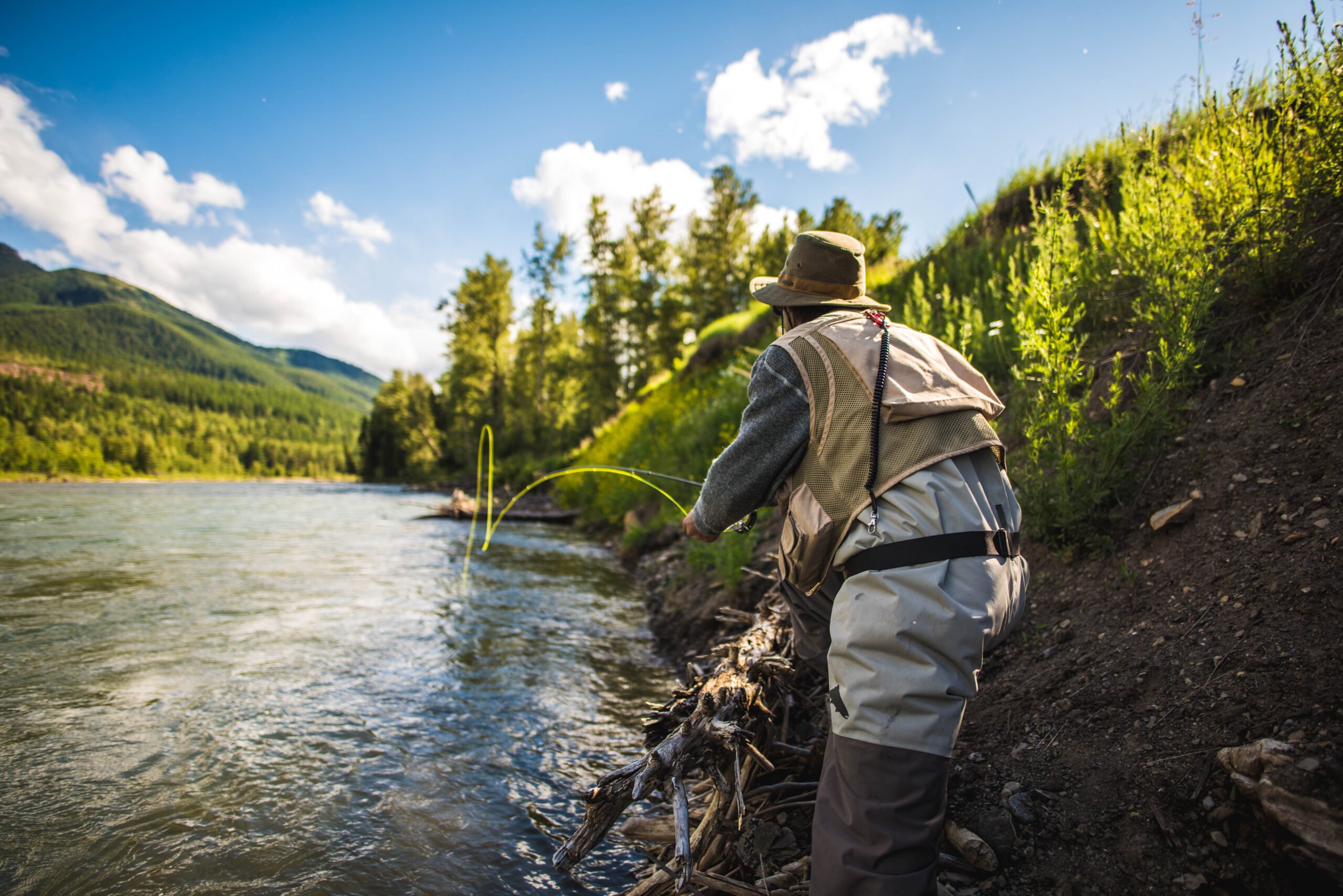My first encounter with the secret river occurred in the summer of 1956, just after my twelfth birthday. It was early
morning, and I had walked to a new section of the large trout stream near home. It was a long walk, but I was an initiate fly fisher, and I set out in eager anticipation of using my newfound skills to finally conquer the big browns that I knew inhabited the stream.
I was slogging along in the shallows at the edge of a long riffle, headed for a big, downstream corner pool. My oversized hip boots (“He’ll grow into them”) slipped and slid on the rocks, and I moved slowly, afraid of twisting an ankle. Suddenly, right there in front of me, was a truly big brown trout. We saw each other in the same instant, and the fish’s reaction was as startled as mine. It blasted out of the inches-deep water into the heavy flow of midstream, as I cast furiously after it. I later understood that it had been in the shallows hunting Isonychia mayfly nymphs that were hatching at that time of year.
Advance 30 years, and my wife, Nancy, and I were fishing near Twizel on New Zealand’s South Island. The evening was mild beneath a deepening blue sky, and the fish were rising. Nancy fished a long riffle and was into fish immediately. I headed up to the long pool above. Standing at stream edge and scanning the quiet, dark surface, noticed a big nose poke out about 40 feet upstream, close to shore. It was an easy cast. No trees behind, and none overhanging the water. The 4-weight line settled quietly to the surface. But that was the end of quiet. The water erupted as several big fish tore out of the shallows in panic. Foolishly I had not thought that other fish could be in the secret river.
The secret river is not a specific river, but a specific location on every river. It’s a place that every angler who has ever floated with a guide has experienced, but still doesn’t seem to understand. “Where did the guide ask you to cast?” I questioned the audience at a fly fishing show. “To the bank,” they chorused back. And that is very true. “But the next day when you went back to fish the same water, you waded where you caught the fish, and cast to where the boat was floating, didn’t you?” I pointed out. Silence. Suddenly everyone understood why I call it the secret river.
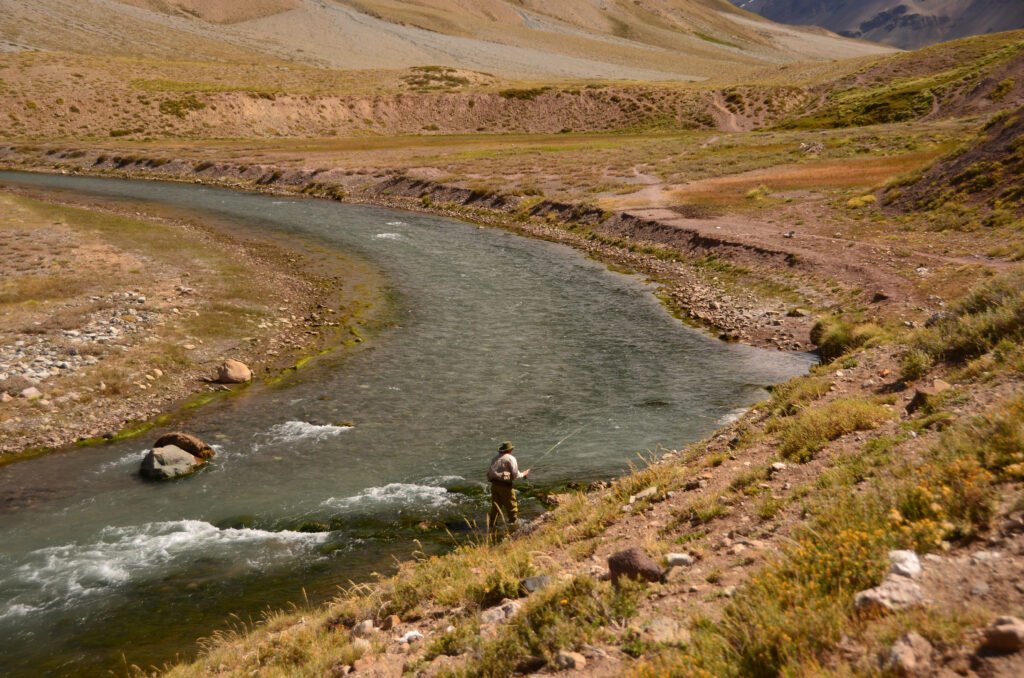
The secret river is the place most of us wade so we can reach the fish that are in mid-river. They’re in mid river because we chased them out of the secret river and into midstream with our wild-eyed wading. No place is this more evident of this than on Montana’s Madison. Frequented by literally thousands of anglers a year, this incredible trout fishery still gives plenty of great days of angling to all those who search for its rainbows and browns. But few catch the really nice fish—those over 20 inches.
My favorite time to fish the Madison for its bigger fish is after everyone has left for the evening. About an hour before dark, anglers begin abandoning the currents for the eateries in West Yellowstone, or other areas, and then head off to their respective hotels for the night. When I see the last of them clearing the parking lot, I set up my rod with an 8-foot leader ending in a 2X tippet. After knotting on a size 2 or 4 White Wulff, or other highly visible imitation of like size, I clinch knot a 15 -inch piece of 5X to the hook’s bend, and add a size 16 Iris caddis at the end.
I take only the set-up rod. No vest, no waders, no sunglasses, not even a hat. I find a nice smooth rock to sit on close to a section of the secret river that is at least knee deep, smooth flowing, and preferably with some big protruding rocks. Then I just sit and watch. As the day disappears, and night begins to creep across the stream, I see a big nose poke out. No casting. Just sitting still and watching. After a few moments, another nose pokes out. Still I sit. After about five minutes, I have four nice fish working within 20 feet of my position. Time to cast.
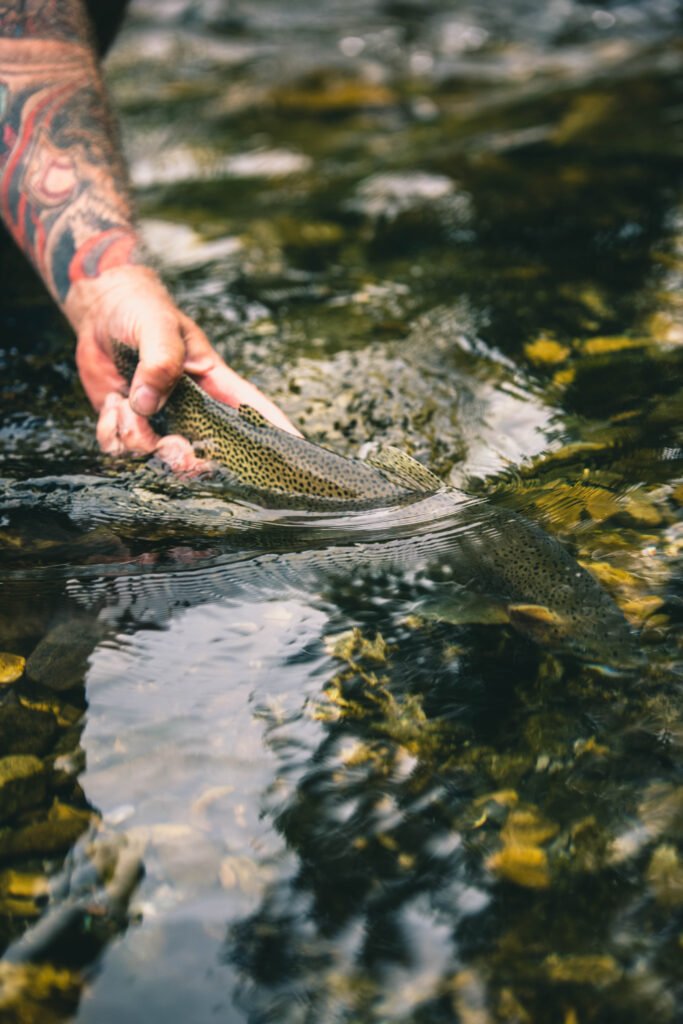
One cannot possibly hope to see the tiny caddis emerger, but the husky White Wulff is highly visible, even in the gloaming. It floats over the point where I saw a big nose poke out, and then there’s a rise close to the big marker fly. Tightening, I connect to a very healthy brown. And so the evening goes. I’ve caught more 20- to 23-inch browns from the Madison using this marker fly tactic in the secret river than by any other method at any other time. But fishing the secret river is not just for late evening fishing. On bright days, the fish may be in the secret river if the waters are not highly disturbed. One year, my son, Jason, and I were fishing the Spearfish River is South Dakota. Not a large stream, it nonetheless can hold some very nice trout. I was on one side and Jason on the other as we fished carefully upstream. Suddenly I notice a fish flash fly about 20 feet upstream from Jason, and tight to the bank. The water was only a few inches deep, at best. I called to Jason and told him where to cast. The fish took on the first drift. Suddenly it was all too easy. He spotted my side, and I spotted his side. We alternated fish as we moved along. All of them were in the secret river within a foot or two of the shore. It was a delightful day filled with fish, and the fun of spotting for each other.
New Zealand is the land of the secret river and spotting fish. The best way to fish the rivers of the Antipodes is to very carefully stalk the banks, staying well out of sight, and watch for big fish holding in the near-shore shallows of the secret river. And then, it’s one-on-one. Predator versus prey. If the fly rodder is in the least clumsy in the cast, or rushes the stalk, the fish is gone. It’s presentation skills at their pinnacle.
My wife, Nancy, and I were fishing the upper Dingle River on New Zealand’s South Island with our friends, Bob and Beverly Pelzl. It was a blue-sky day under a wonderfully bright southern hemisphere sun. But even though the water was atmospherically clear, and the sun high overhead, we had to use every skill we had to spot the big fish. It’s amazing how well camouflaged they can be. First, we used tan polarized sunglasses. Tan because most stream bottoms are some shade of tan, and tan glasses allow the greatest contrast between dark and light areas. Then we watched every potential lie very carefully. Sometimes, after watching for a minute or two, we would start to move and flush out a particularly nice fish which we hadn’t seen, lying within inches of shore. We watched particularly for the fish’s shadow, simply because their color blended so well with the rocks, and because the often riffly water hide the rainbows so well, even though some were two feet in length. We spent time looking at long things rather than at round things—fish are long and rocks are round. We also watched very carefully for movement—the flash of a fin, the flick of a tail, the turn of a head.
Once a fish was located, then came the stalking strategy. Most anglers simply do not have any strategy for approaching the prey. Most just wade along blithely, flicking the fly to potential lies. Not a strategy for New Zealand. No, one needs to plot every detail. But, with a bit of careful stalking and careful casting, the Dingle’s big rainbows fell one after another to nymphs and dries. It was an exceptional day.
Anglers fishing the secret river, no matter where, need to pay heed to New Zealand strategies. Certainly not all rivers are as clear as those of that island nation, and mostly the fish are not as large. But fish in the shallow edges are just as spooky in any other place in the world, and the fly fisher needs to pay attention to every detail. Joe Brooks probably said it better than anyone when he coached, “Fish it before you wade it.”
Typically when nymphing the secret river, I will fish upcurrent. I use a larger, white indicator (which looks like a gob of foam) to act as a “suspension device” so my fly doesn’t get hung in the bottom every other cast. I position it up on the leader at a distance equal to the depth of the water in which I’m fishing. Typically I’ll fish a couple of small bead heads, or a use a small split shot with a couple of unweighted imitations. And I’ll typically use the Shotgun Tactic. Cast upstream only 20 to 25 feet, and lift the rod as the fly drifts back about 10 feet. Then immediately pick it up and recast. Make 20 casts or so to cover the width of the secret river before moving up 10 feet and repeating the process. Don’t rush, pay attention, and cover the water well.
Fishing a high-mountain river in Argentina, a river not unlike a slightly smaller Madison, I was startled to see Exequiel Bustos, who was fishing with me that day, wade out into the heavy currents of mid river and turn and cast to shore. I knew immediately what he understood. The fish were not in the fast, heavy flows of mid-river, they were in the secret river along the shore line.
I immediately set up my “secret river” rig and began probing the calmer waters along the banks with the Shotgun Tactic. It was the right move. We took fish all day. Nothing too large, but certainly enough fish to make the day more than worthwhile.
Many fly fishers are stumped about making a backcast when the rod is nearly vertical at the end of the Shotgun Tactic drift. Simply turn your torso toward your casting arm side, drop the rod tip a bit out to that side, and make an elliptical stroke. Make the backcast a bit sidearm, and then, during the pause, bring the tip up and around 24 and make the forward cast with the rod more upright. The elliptical stroke is essential because it’s the way one casts shot, weighted flies, sink-tip lines, big air-resistant imitations, etc. without hitting one’s self or tangling the flies.
When fishing a dry, I classically fish down and across stream. I make a 25 to 30 foot cast, checking the rod, and drawing it back to vertical as I shoot extra line (a parachute mend). This allows me to lower the rod as the fly runs down. I can thus dead-drift the imitation about 15 feet, and then allow it to drag and skate across to my side. If it sinks on the skate, I just fish it across that way. It’s surprising how often a fish will grab the swinging fly.
Too often, fly rodders fishing the floating fly will lift the imitation at the end of the swing and make a nearly endless series of false casts to dry the fly before making the next fishing cast. Don’t do that. Use the “C” pickup. Snap the rod tip around in a “C” movement, starting at the top of the “C” and ending at the bottom, and then immediately, without pause, lift the line into the backcast. The line pops off the water and jumps around, snapping the water out of the fly. The dry imitation can immediately be recast to potential lies. It’s amazing how efficient this tactic really is—every cast is a fishing cast.
Reading the secret river is not really difficult, but pay attention to both depth and current speed. Water less that knee deep can certainly, and often does, hold good fish. I usually find them in such places early and late in the day or during a good hatch. Not always, but usually. Fish in such areas are usually quite spooky; they know they are exposed to predators. If the water in the secret river is knee deep or more, then fish will most likely be there all the time (a prime lie). Such places require careful and thorough attention.
And remember, the secret river can be any width. For example, in a heavy, curving riffle the secret river on the inside of the curve can be wide and shallow. On the outside of the curve, the secret river will be narrow and often rather deep. Fishing in Patagonia, I came to just such a place. It was great spot for a nice fish or two. I switched to a large, black Strip Leech, and began fishing downstream from the top of the riffle. I positioned myself at the top of the shallow water on the inside of the curve. Casting across and slightly down, tight to the far bank, I allowed the big imitation to swim along and dead drift in the narrow secret river on the outside of the curve for a couple of feet and then allowed the currents to swing it across to my side. Once it was hanging downstream from me, I worked the fly back for a few feet, moved downstream two steps and recast.
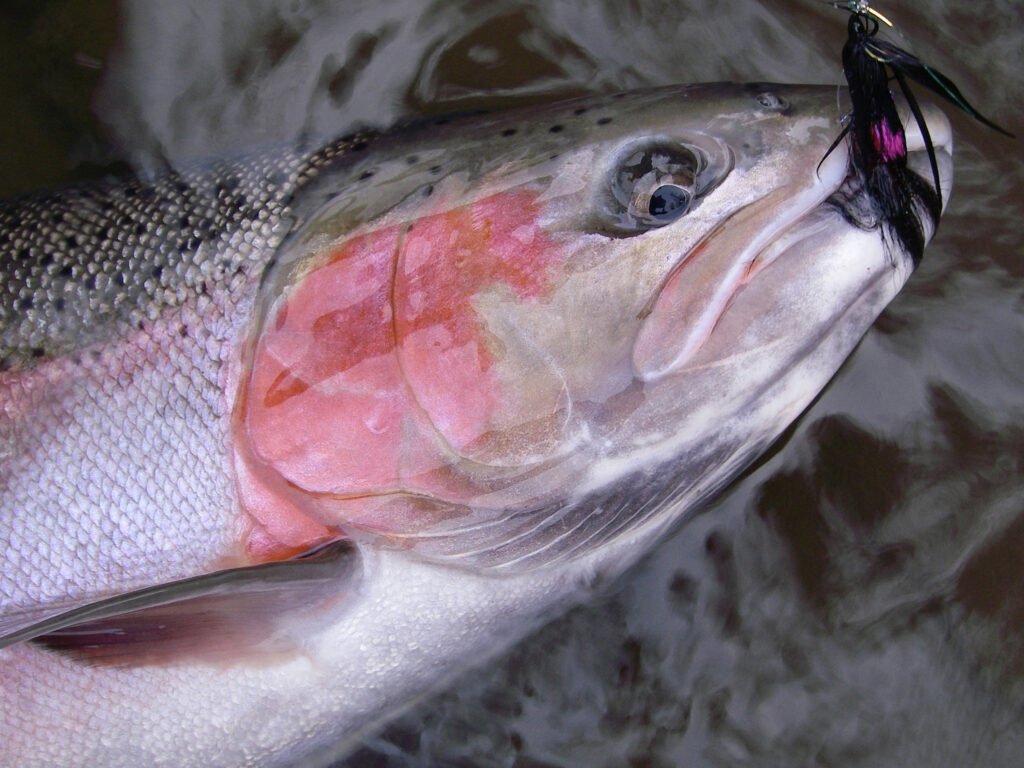
The retrieve on my side, in the shallow secret river on the inside of the curve, took a couple of smaller fish. Nothing of any size seemed to be in the riffle area. Still I fished on, two steps, repeat. Then, moments after the fly dropped to the surface, tight against the far bank, the line jerked tight, and I was fast to a very nice rainbow. It was the only big fish I took from that riffle, but its fight, and its husky size, made seeking it out, two steps at a time while casting to the secret river on the outside of the bend, more than worthwhile.
Another time, fishing New York’s Salmon River, we located a spot very similar to the one in Patagonia. The bend was not as sharp, and so the secret river on the opposite shore was several feet wide, but still fairly deep—and I might note, filled with steelhead. Three of us rotated through the secret river and landed over twenty of the chrome-bright steelies in an evening’s fishing.
One of the reasons that the secret river is so attractive to fish is that the currents are slow, the fish can hold without the threat of being washed away, and it’s much easier to watch the surface drift. In the quieter waters of the secret river, fish can simply hug the bottom and be protected from currents.
Anglers who regularly fish the Henry’s Fork of the Snake have come to appreciate the secret river above all other potential lies in the river. When a hatch is on, the big fish line the banks and feed heavily. Anglers who have not fished the Fork with any frequency classically march up and down the banks, watching for mid-stream rises. Those who know the Fork find a spot where they can watch the water close to the bank, and then they just sit and wait. When a big nose is sighted, the anger wades out and carefully moves into position to fish down and across, drifting the fly in the quiet currents along the shore. It’s deadly.
Pay attention to the secret river. It can be your secret to a most successful day.
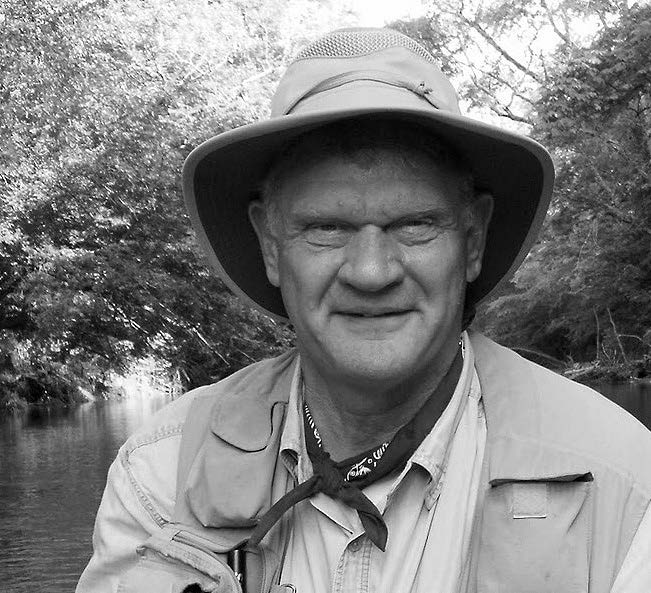 Gary Borger is one of the world’s foremost fly-fishing educators. He has taught classes and lectured internationally on all aspects of fly fishing for trout and salmon since 1972. He is recognized as one of the world’s leaders in fly designing. He holds a Ph.D. from the University of Wisconsin-Madison and is Professor Emeritus at the University of Wisconsin Campus in Wausau.
Gary Borger is one of the world’s foremost fly-fishing educators. He has taught classes and lectured internationally on all aspects of fly fishing for trout and salmon since 1972. He is recognized as one of the world’s leaders in fly designing. He holds a Ph.D. from the University of Wisconsin-Madison and is Professor Emeritus at the University of Wisconsin Campus in Wausau.
© Photos Curtis Hall, curtishallphoto.com, @curtishall_
